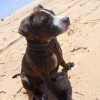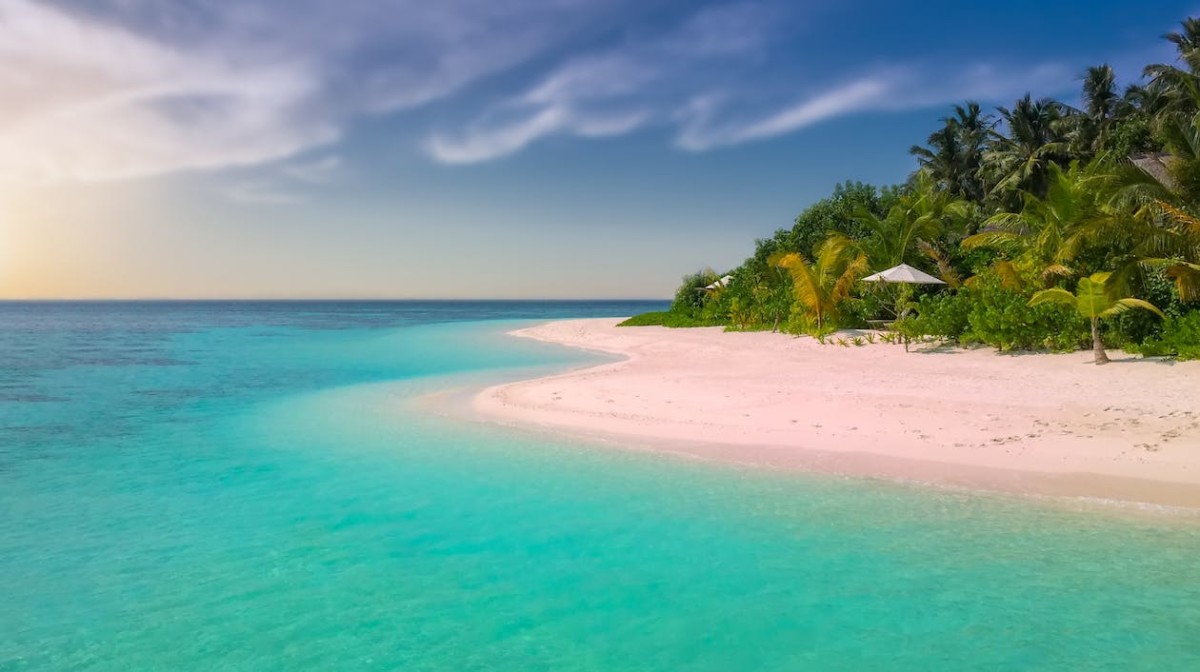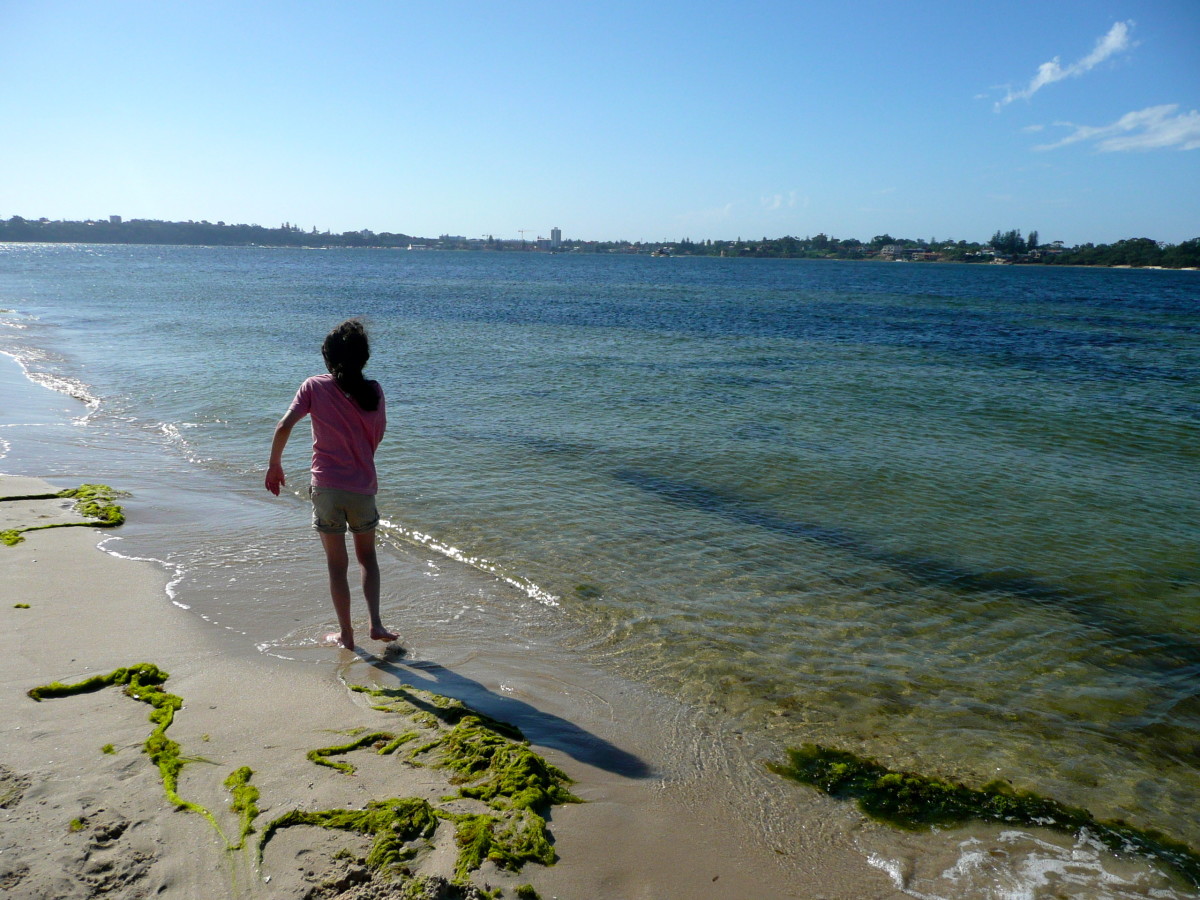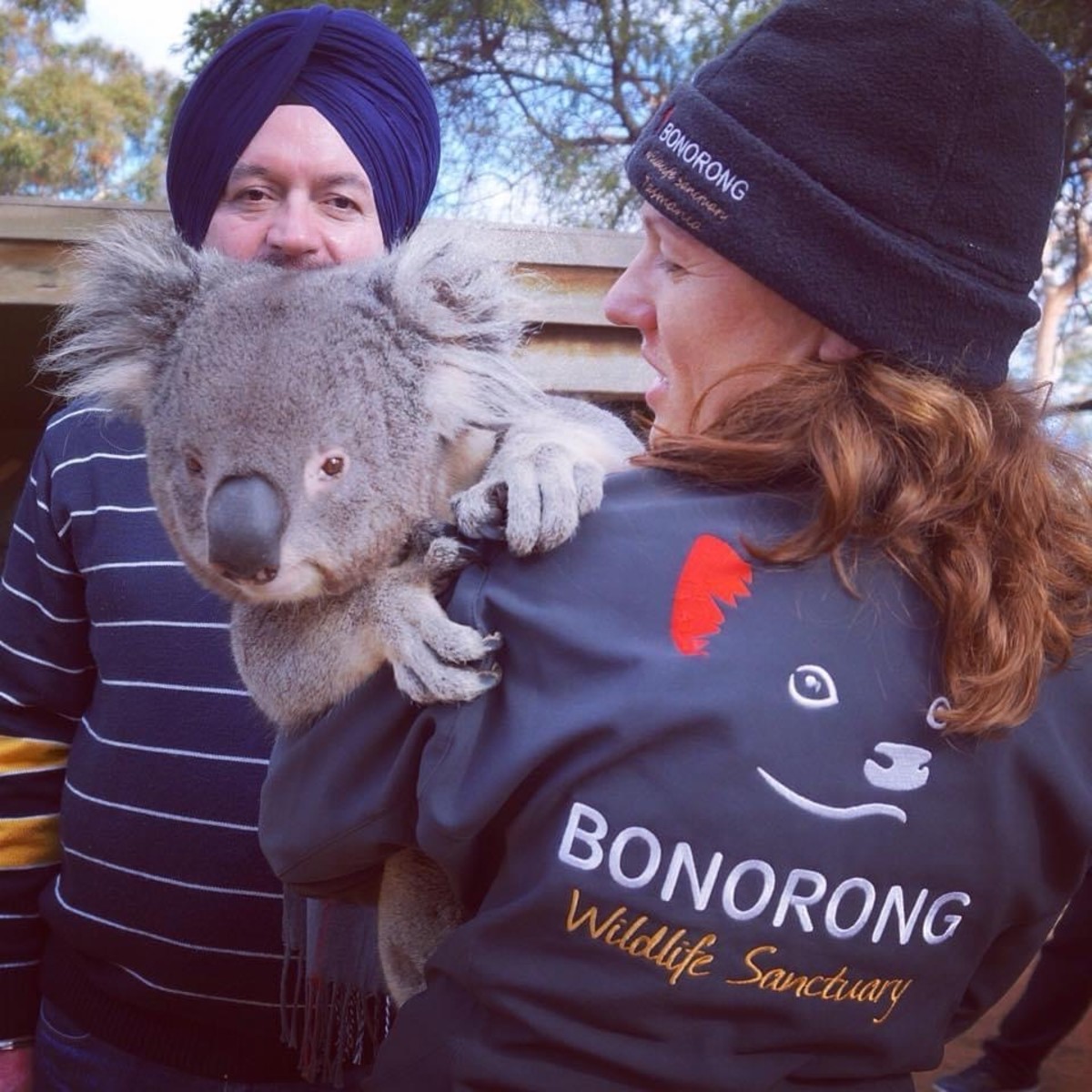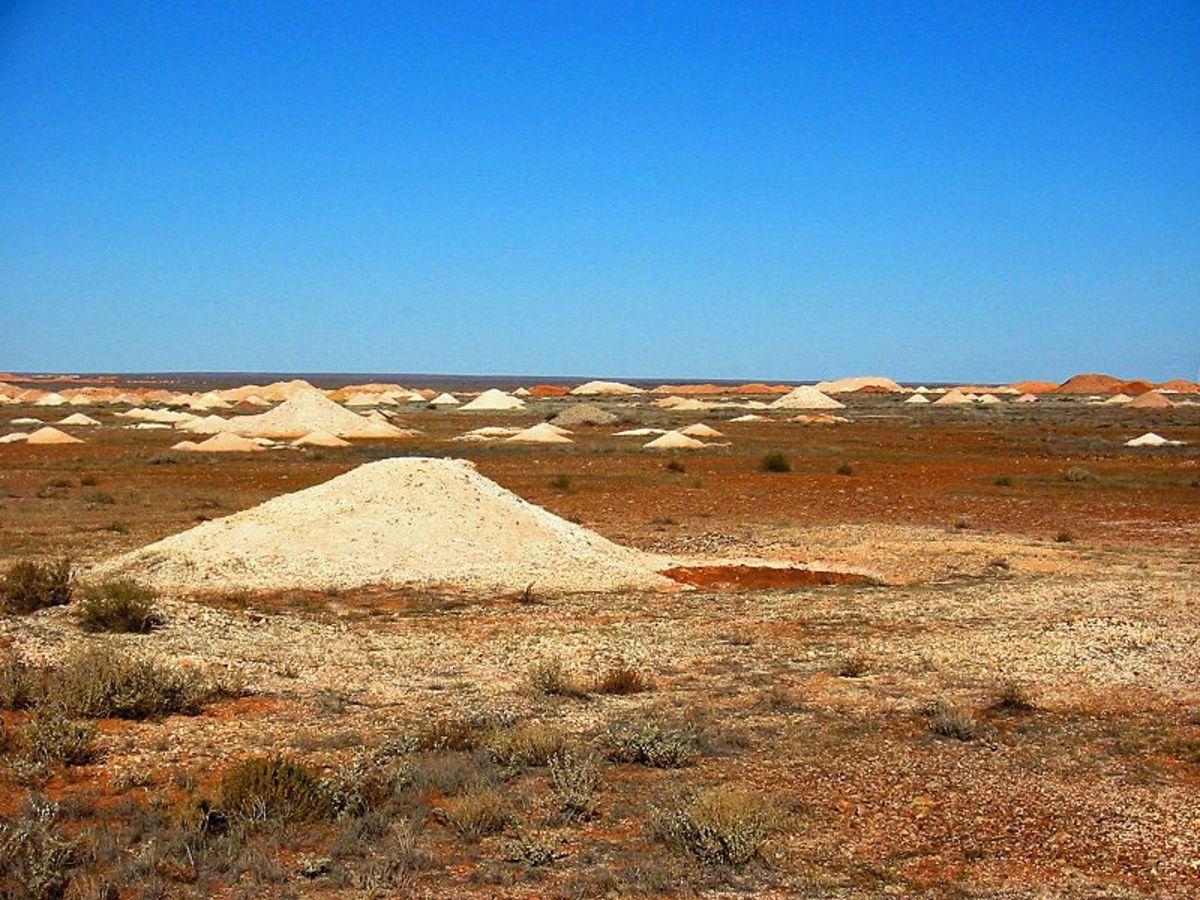FRASER ISLAND, Queensland, Australia
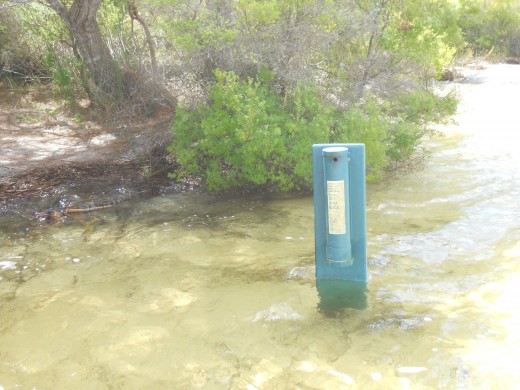
Having been to Fraser Island a few times before, we were keen to head back again, so when a friend said he was heading up over the Easter break, we were there! We ended up with 3 cars and 8 people heading up. Six of us were heading from Sydney so we had a long drive ahead of us. It’s just under 1,200 km from Sydney to Rainbow Beach, where you get the barge from. As we only had 7 days and wanted to spend as long as possible on the island we drove straight through in 1 day, staying overnight about 40min outside of Rainbow Beach at a place called Gympie.
The other couple we were meeting live in Brisbane and only had about a 2 hour drive, so they headed up to the island earlier to secure our campsite. We prefer beach camping on the eastern side of the beach, generally around “Cornwell”, but there are numerous options for accommodation on the inland – beach camping, actual campgrounds with toilet/shower facilities, resort accommodation, units and houses to rent, enclosed “bush” campgrounds.
Although there are a number of points you can get onto the island from, we generally get the bargeacross from Rainbow Beach. From dawn to dusk every day the Rainbow Venture and Fraser Explorer barges run constantly between Rainbow Beach and Inskip Point and there is no need to book. The journey only takes about 10 minutes to cross and at the time of writing the return barge ticket was $100.
If you buy your barge pass from the Shell Service Station at Rainbow Beach(on the left hand side of the main road heading into town) and fill up with fuel at the same time, you get a discount off your fuel.
Camping permits and Vehicle permits must be pre-booked before you get onto the island (rangers are always out in force, so don’t risk it!). You can book your camping pass & vehicle pass through the Queensland Government's Environment & Resource Management website or offices.
At time of writing the camping was $5.15 per person, per day and vehicle permit was $39.35 for 1 month.
It’s amazing how much there is to do on this one island. We’ve been a number of times and there is still more for us to see! This time, with all the rain and floods that Queensland has encountered this year, the lakes were all so full and it was amazing to see this transformation. There were sign posts and walking tracks actually in the water! Half the beach was gone at Lake Mackenzie, there was just so much water!
Map of Fraser Island
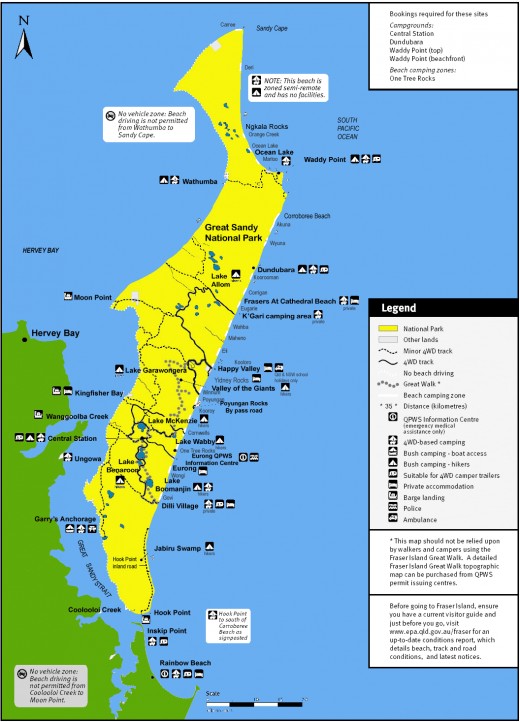
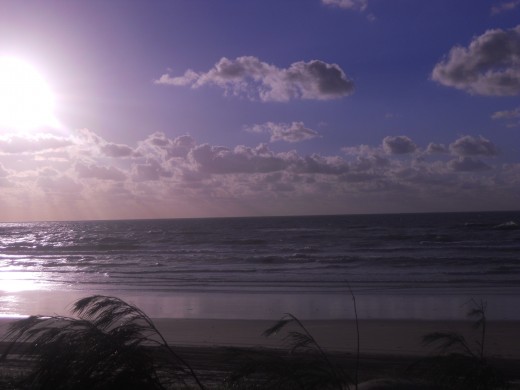
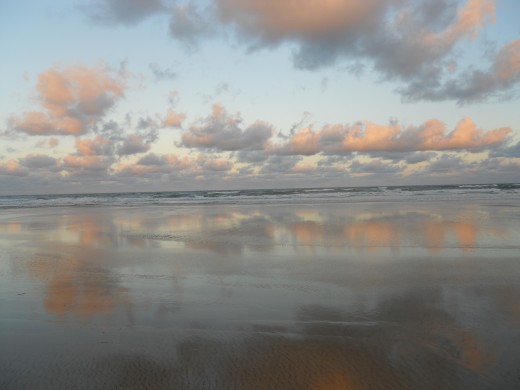
Fraser Island Information
Fraser Island is located approximately 300km north of Brisbane. Fraser Island has a World Heritage Listing and stretches over 123km in length and 22km at it's widest point. Fraser Island is the largest sand island in the world.
A visit to the island will see you viewing sand dunes, coloured sand cliffs, over 100 freshwater lakes, long white sandy beaches, dingoes, turtles, birds, frogs, rainforests, wildflowers ........ the list is endless.
Below is some important info if you are intending on visiting Fraser Island.
- Open campfires are prohibited on Fraser Island except in the communal fire rings provided by EPA at certain campgrounds. If using one of these fire rings you must bring your own firewood from the mainland.
- Take your own drinking water and containers. Drinking water can be collected from various taps on the island. All other taps, lake or stream water is not suitable for drinking unless treated.
- Bookings are required for most campgrounds on the island (and some beach camping zones). You will require a camping permit for general beach camping anyway though.
- Take all rubbish with you, do not leave anything behind when you leave your camp. Waste transfer stations are provided at certain locations on the island. Always keep rubbish in a bag or box and lock in your car at night to stop the dingoes getting to it. Dingos can and will open esky's and boxes that are left out.
- Mobile phone reception on Fraser Island is limited and you shouldn't rely on this as your only communication method. Generally you will get reception at Kingfisher Bay with most providers, but other than that it is limited. My Telstra Next G phone had reception on and off throughout the island, but other travelling companions did not have the same coverage with other phone companies.
- Take all medical and first aid supplies with you. Note that there are no pharmacies, doctors or hospitals on Fraser Island. I believe there may be an Ambulance station that operates during peak visitor periods.
- There is a mechanic on the island if you do find yourself in trouble, but visiting this mechanic is an experience to say the least! I might just leave it at that!!!
- A CB radio is a handy thing to have in your car, especially if you are travelling with other cars.
The 'Fraser Island' Dingo is believed to be the purest strain of Dingo in Australia. They roam freely on the beaches, bushland and rainforest and seem quite happy with the locals and tourists. It really is a treat when you see your first “wild” dingo, but the more time you spend on the island, the more you see and they end up just being common place. Generally they don’t tend to interact with humans and as long as you keep out of their way, they keep out of yours. Of course you have the odd dingo-human “meeting”, and unfortunately these don’t always turn out the best.
On our last visit to the Island, unfortunately a 3 year old girl was bitten quite badly on the legs by two dingoes. This made Australia-wide news and the dingoes were caught and destroyed. This must have been terribly traumatic for the child and her parents and it’s very lucky that her injuries weren’t more serious. BUT, you must remember that these are wild animals and should be treated with that respect. I won’t go into details about the story or my personal views on the situation, but anyone visiting Fraser Island needs to remember that dingoes live there, they are wild, they don’t have ready access to food and occasionally they may attack. Parents need to keep a constant eye on their kids and adults also need to be responsible and look after each other. Don’t leave food lying around, don’t wander off by yourself at night, don’t feed the dingoes.
It is against the law to feed the dingoes and there are quite high penalties if you are caught intentionally feeding them. There are a number of reasons for this, the two main ones being a) it upsets the natural balance of the ecosystem where they should forage for their own food and b) it encourages the dingoes to hang around campsites waiting for handouts and c) it makes the dingoes less wary of humans and therefore the possibility for more attacks.
The dingo is a scavenger and, given the change, will quickly steal anything that smells like food! They will open bags and esky’s and anything else you leave lying around. We always keep food and rubbish locked in the car. We learned our lesson during our first visit to the island a number of years back – we had just arrived and set up camp, my partner put a plastic container containing a sandwich on the table, he walked about 3 meters away (i was inside the tent), i heard a noise, looked out the tent and there was a dingo standing on the table eating the sandwich!! We learned then and there how cunning and quick the dingoes are and to never, ever leave anything out!
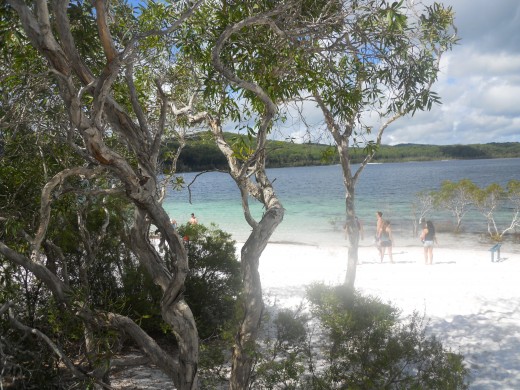
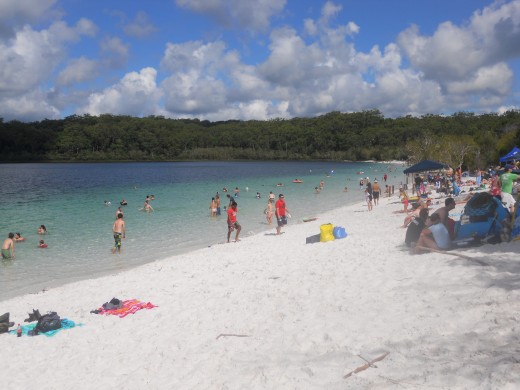
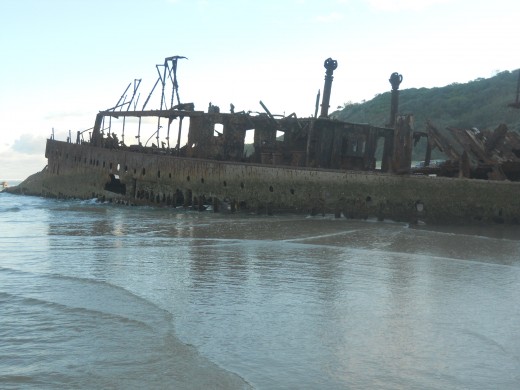
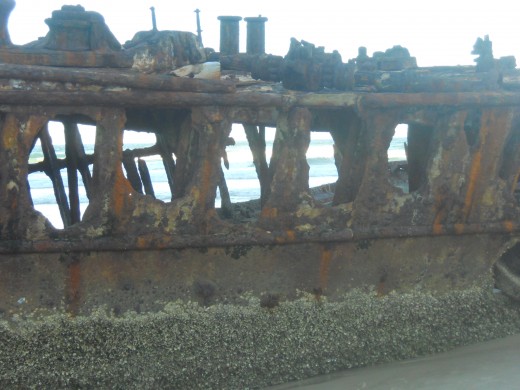
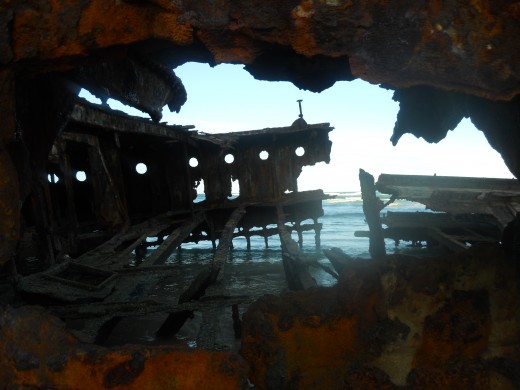
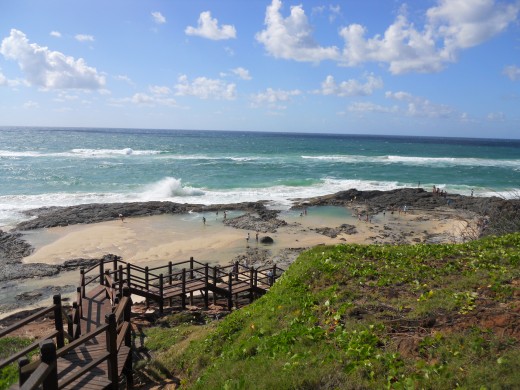
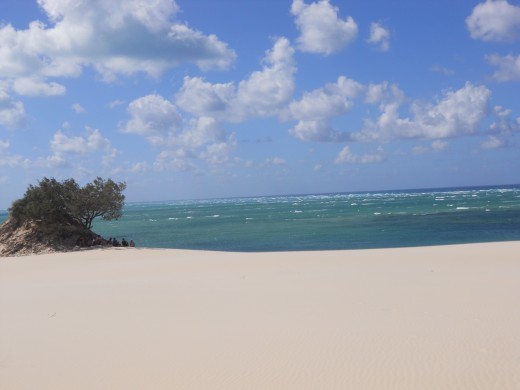
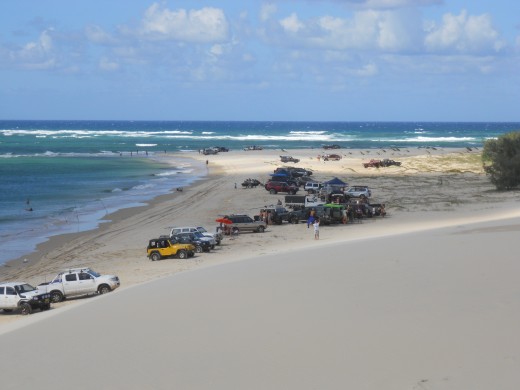
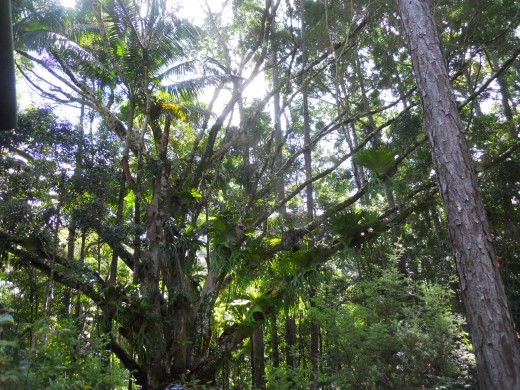
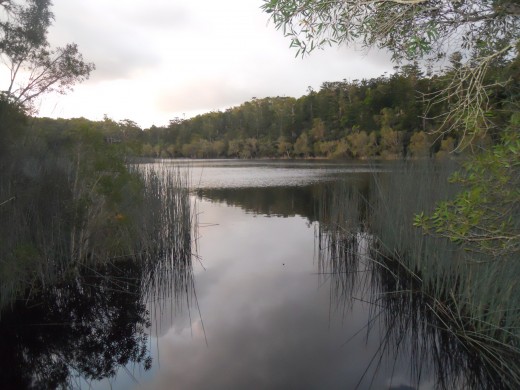
Things to See on Fraser Island
There are many, many things to see and do on Fraser Island, but the list below is some of the more popular or, in my opinion, better attractions.
- Lake McKenzie - This inland, perched lake is a very popular site, probably the most popular place on Fraser Island! The white sand and sparkling blue water is truly amazing. Perfect place for a swim or just sit and look at it's beauty. Although a recent upgrade of parking and toilet facilities has taken place, parking is still at a premium so try to go early or late in the day.
- Lake Allom - This little lake is tucked away in a rainforest hollow and offers a cool respite from the beach environment. A circuit walk track around the lake meanders through a variety of plant communities. The highlight of a visit to Lake Allom is the viewing platform where you can watch freshwater turtles swimming about. When we were there last we saw about 10 or so, swimming right up to the platform!
- Eli Creek - Cool off next to this crystal clear freshwater creek, that flows through vegetated banks and right out to the beach. Watch for eels and frogs from the boardwalk, and see small fish swimming against the current. Eli Creek is very pretty and the boardwalk is a nice touch, but IT IS COLD! Don't know why, but whenever we have been there, the water in this creek is like ice!!
- Sandy Cape - Sandy Cape is at the northern most tip of Fraser Island and it is where the Sandy Cape Lighthouse sits. It's a very popular spot for fishing. Heading up to Sandy Cape is pretty remote and the conditions are very unpredictable. You need to travel at low tide, and as it's about 90km from Eurong, you need to prepare for this. We had no trouble driving up and back, but did encounter a few other vehicles bogged in sand or stuggling with the inland tracks.
- Lake Boomanjin - This is the largest perched lake in the world, covering almost 200ha. Its waters are stained brown by tannins leached from the vegetation.
- Champagne Pools - Located north of Indian Head, along the Eastern beach. These pools are a very popular swimming hole, where the ocean crashes over the rocks into small sandy rock pools. The name Champagne Pools comes from when the foaming water crashes over the rocks. Very pretty place and nice to laze around in these little water holes. Strong currents and lots of rocks though, so don't recommend swimming outside of the rock pools and be very careful when walking around. Sometimes you can even see little nemo fish swimming around in the waterholes.
- Central Station - Many walks leave from Central Station. Stroll through the rainforest along Wanggoolba Creek boardwalk, visit the peaceful Basin Lake, or stand among some impressive satinay trees in Pile Valley. Nice boardwalk circuit walk through the rainforrest. And check out the Kauri Pines filled with the biggest Staghorns i've seen.
- Lake Wabby - This is the deepest lake on Fraser Island. Its shore lies at the edge of the Hammerstone Sandblow. Drive around (Cornwell's Break Road) and up to the ridge above the lake, where a short walk takes you to a lookout offering a view of the lake and the sandblow that is slowly engulfing it.
- Kingfisher Bay - Sheltered coastline, impressive views across the Great Sandy Strait and historical sites are all within easy walking distance of Kingfisher Bay. The Kingfisher Bay Resort is here, with bars, restaurants, pool all available for day visitors.
- Wungul Sandblow - Enjoy expansive coastline views from the first dune crest of this sandblow.
- Waddy Point headland - Take in a vista of beach and ocean. Watch for sea turtles, sharks and stingrays coasting along.
- Binngih Sandblow (Waddy Point) - Catch sweeping views across Waddy Point headland and north over Marloo Bay to Sandy Cape, the site of the only lighthouse on Fraser Island.
- Ocean Lake - Ocean Lake is home to a variety of water birds taking advantage of the reeds and undisturbed sections of the lake. Nearby, an easy walk through cypress, banksia and melaleuca woodland offers a good lookout with panoramic views.
- S.S. Maheno The Maheno was built in Scotland in the early 1900’s as a luxury passenger ship for trans-Tasman crossings. During World War 1 the ship served as a hospital ship and then I believe it returned to being a luxury liner for a number of years. The Maheno was later decommissioned and sold to a Japanese shipping company and was being towed to Japan when it was hit by a cyclone off the coast of Fraser. The Maheno drifted ashore and was beached on the eastern beach of Fraser Island. Although the ship is now very rusted and deteriorating with each visit we make to the island, it is a great thing to see. Low tide is the best time to view this as you can see pretty much right around the ship. For obvious reasons you cannot touch or climb in the shipwreck.
Some of the information above was taken in part from the http://www.derm.qld.gov.auwebsite – check it out for some excellent information on Fraser Island (and all other Queensland National Parks)
Facilities on Fraser Island
Fraser Island is fairly remote and facilities are limited. At various towns you will find limited take-away, general store, petrol, public phones. Although it's a good thing to buy the odd supply in the shops as you are putting money back into the island and locals, I’d advise to try to take all supplies with you from the mainland and not fully rely on the services from the island. Supplies and services are very limited and you will pay more for everything on the island!
Kingfisher Bay Resort (on the western side of Fraser Island) has a nice bistro, bar, pool, coffee shop, retail store .... all of which is available to day visitors, ie you do not need to be staying in the resort.
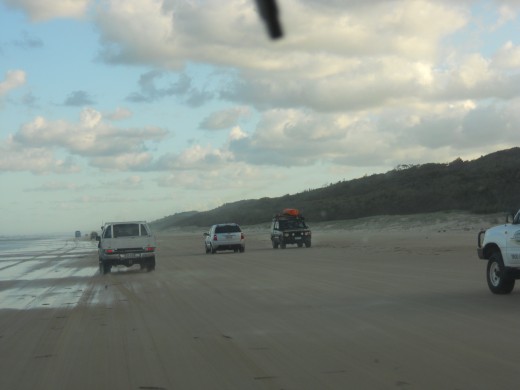
Driving on Fraser Island
Normal road rules apply when driving on the island, eg indicating, keeping left, alcohol limits, speed limits. Police do patrol the island, especially in holiday season. Last visit we were breath tested numerous times and the police presence was definitely a lot greater than we have ever seen.
Although laws have been changed and tightened in relation to rental vehicles on the island, there are still a lot of rental vehicles and inexperienced drivers so you have to be extra careful. Even experienced 4WDers like us need to always keep an eye out on the other cars around you.
- Always remember to let your tyre pressures down! Should be common sense, but some people forget this step!!
- Seatbelts must be worn at all times.
- Sand driving takes a lot of skill as beach conditions can change very quickly. A long stretch of hard sand, can quickly change to soft sand, holes, water crossings, drop offs.
- Always stay clear of the water as waves can cause accidents. Drive between the low & high tide marks on the firmer sand if possible.
- Always try to travel at low tide (or within 2 hours either side of it).
- Avoid sharp braking or cornering on sand.
- When parking on the beach, park at an angle so ongoing cars can tell you are stopped.
- Eastern Beach speed limit is 80 km/hour and inland tracks are 35km / hour. Various other speed limits are signposted where necessary.
- Most inland roads are single lanes so travel safely and at an appropriate speed as you will inevitably need to pull over to let vehicles pass from time to time.
- Watch out for Planes! Planes do land on the Eastern Beach of Fraser Island!Aircraft landing zones are signposted and marked with orange cone markers along the beach. Planes need to land on the harder sand close to the water's edge, so vehicles generally move to the upper beach to pass.
- Always give way to, and be on a watch out for, pedestrians, fishermen, dingos, wildlife
Night Driving
If possible it is always best to avoid travelling at night. If you don’t have good spot lights on your 4WD, don’t even attempt it at all! The beach is totally different at night and it takes a lot more concentration. Water crossings and holes are harder to see, rocks may be exposed that you may not have seen before.
People are near impossible to see if they happen to be on the beach. And of course, should something happen to you and/or your vehicle, there may not be anyone around to help you.
We have travelled at night out of necessity and would definitely not recommend it.
What To Take / How to Pack
- Clothing - Don't forget your swimmers & hat (don't be surprised, i've known people to not pack them!). A jacket for nighttime as it can get cool.
- Tent - Extra tent poles, tarps, ropes, sand pegs - don't forget the sand pegs! Some glue, tent repair kit, tape etc will all come in handy as well for any little accidents!.
- Remember if you are a smoker, take a small sealable container to collect your cigarette butts in.
- Lighting - Lamps, lanterns are necessary for around the campsite, but a small personal torch is also handy for nighttime toilet trips! Head lamps are the best thing to have as they keep your hands free and provide a surprisingly large amount of light - perfect for cooking, eating and reading.
- Water - Normally you'll have 20L water containers or similar, but a smaller, say 5L container is handy for cooking, washing hands etc, rather than taking out the big one each time.
- Meat – If possible try to cryvac / vacuum packall your meat (get the butcher to do it or do it yourself if you have a machine). Meat packed this way will keep in the fridge (not freezer) for longer. Do some research yourself about this as different meats keep for different periods of time etc, but as an exampe, we've had steak in the fridge like this for 4 weeks and it was fine.
- Fruit & Vegetables -Wrap individually in paper towel and newspaper so that if one item goes off or gets squashed, you do not risk spoiling all your food supplies.
- All dry foods should be put into containers with screw top lids if possible to stop spills.
- Try to take plastic containers rather than glass bottles where possible.
- Alcohol – Take cans, not bottles. Cans won’t break, are easier to store as they pack on top of each other and are better rubbish-wise (they will squash down). .
- Insects - The march flies are bad! You will want to remember your insect spray. If you have never seen a march fly, you are in for a treat! These things are like baby birds landing on you - ok that was a little of an exaggeration, but they are BIG ........ and they bite! Most tropical strength sprays will work, but some of the normal ones seem to attract the flies rather than repel them! Citronella candles and oil can be used for mosquitoes. Coconut soap and coconut oil apparently also repels mosquitoes.
Camp Cooking
Camping doesn’t mean you have to live on sausage sandwiches and baked beans! I enjoy cooking so I don’t see camping as my time to relax and not have to prepare meals, but not everyone is like me! We eat very similar meals whether we are at home or out in the bush. It does take a while to get used to camp cooking, as you don’t have your whole kitchen, pots, pans, utensils, spices etc at your disposal, but it’s really not that hard.
Below are some of the easy meal ideas for camping:-
- Chicken Schnitzel
- Chili Con Carne
- Fajitas
- Grilled Chicken
- Hamburgers
- Hotdogs
- Nachos
- Noodles with egg stirred through
- Omelette
- Pasta – Napolitano, bolognaise etc
- Salad, Sausages, steak, noodles
- Beef Stew
- Rissoles
All these meals can be easily made on just a gas stove or BBQ plate. If you want to get more adventurous with your meals, buy yourself a camp oven, build your campfire and get set making yourself cakes, roast dinners, whatever!
Below are just a couple of my easy camp recipes:-
Easy Chili
500g minced beef
1 can tomatoes
1 tin tomato paste
1 tin diced capsicum
1 onion, chopped
2 cans red kidney beans, drained
1 packet Chili Con Carne Seasoning
Brown mince and onion in a pan. Once it is bronw, add the other ingredients. Simmer for about 1/2 hour. Keep stirring to make sure it doesn't stick and add a little water if it's getting too dry.
Savory Mince
500g mince beef
packet tomato/vegetable soup
tomato sauce
worstershire sauce
tin tomato
tin of corn
carrot (grated)
onion (diced)
curry powder
water
Fry onion and mince in a pan. Add the rest of the ingredients and stir. Add the water, cover and let simmer.
Foil Wrapped Potatoes
1 potato (sliced)
1 small onion (diced)
Butter
Seasonings (garlic, herbs, salt, pepper)
On a piece of aluminum foil, layer potatoes and onions. Top with butter and seasoning. Fold foil and secure tightly. Punch several small holes for steam to escape. Cook on hot coals approx. 25-35 minutes. Turn and rotate often. Can add cheese once fully cooked so it melts slightly.
If cooking over a gas stove, just cook in a pan. To save time, you can par boil potatoes first.
- Kingfisher Bay Resort
Kingfisher Bay Resort official website - Fraser Island holidays relaxation in a World Heritage Listed environment at Kingfisher Bay Resort - four star accommodation and facilities in a natural setting. - Fraser Island, Great Sandy National Park (Department of Environment and Resource Management)
Purchase camping and vehicle permits and pick up all the info you need on Fraser Island
